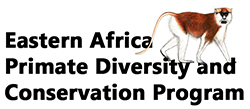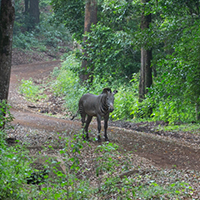
Marsabit National Park and its forest-dwelling Grévy’s zebra and other animals
Thomas M. Butynski and Yvonne A. de Jong
Eastern Africa Primate Diversity and Conservation Program, Nanyuki, Kenya
Marsabit National Park (1,554 km²), located in northern Kenya, is named after Mount Marsabit, a shield volcano (1,707 m asl; 6,300 km²) that last erupted ~600,000 years ago (Scoon 2022). The higher reaches of Mount Marsabit are mostly covered with mid-altitude and montane forest that is dependent on frequent heavy mist to supplement the low rainfall. This unique forest is an island among the arid and semi-arid plains of northern Kenya as it is bounded by the Koroli Desert to the west, the Chalbi Desert to the northwest, the Dida Galgalu Desert to the north and northeast, and the vast, semi-arid, plains leading to Somalia and the Indian Ocean to the east and southeast. Dominant trees in the montane forest include pencil cedar Juniperus procera and African olive Olea europaea africana. Big fig trees Ficus are common. Acacia woodlands and bushlands cover the lower slopes. There are several volcanic craters, some with freshwater lakes (e.g., Lake Paradise, Lake Marsabit, Lake Horr), that offer grazing around their perimeters and drinking water for most, or all, of the year.
The charismatic and ‘Endangered’ Grévy’s zebra Equus grevyi is, today, endemic to central and northern Kenya and central and southern Ethiopia (Rowen and Ginsberg 1992, Williams 2002, 2013, Rubenstein et al. 2016). This species typically lives in arid and semi-arid grasslands and shrublands, hence our surprise when we encountered Grévy’s zebra in the lush cloud forest of Marsabit National Park while conducting an antelope survey in northeastern Kenya. When we visited Marsabit National Park in February 2023, while northern Kenya was experiencing a 5-year drought, we saw 17 Grévy’s zebra within, and in the vicinity of, Gof Sokorte Duda, the crater with a 150-meter-deep caldera in which Lake Paradise is located (1,334 m asl; ~50 ha when full). In January 2024, after the region received good rains in November, we saw no fewer than 10 Grévy’s zebra, including a herd of at least three individuals moving through forest at 1,490 m asl. It appears that this species is resident in the grassland and forest around Lake Paradise.
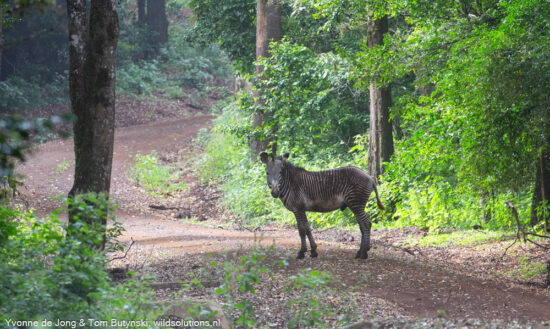
Adult male Grévy’s zebra Equus grevyi in montane forest at 1,490 m asl in Marsabit National Park, northern Kenya.
Williams (1981) lists Grévy’s zebra among the mammals present in Marsabit National Reserve (which, at that time, included today’s Marsabit National Park). He also states (p. 70), “Reticulated giraffe are common on the mountain, where they have taken to spending much of their time in the forest—a most unlikely habitat for giraffe.” During the few days that we were in Marsabit National Park we did not encounter giraffe.
Historically, Grévy’s zebra occurred widely in the Horn of Africa east of the Eastern (Gregory) Rift Valley from central Ethiopia southwards to central Kenya and southwestern Somalia. This species is, apparently, now absent from Somalia. The populations in Ethiopia and Kenya are discontinuous and widely scattered (Rowen and Ginsberg 1992, Williams 2002, 2013, Rubenstein et al. 2016). Reintroduced or introduced populations are present at several sites in Kenya, including the Tsavo Conservation Area, Oserian Wildlife Sanctuary, and Ol Pejeta Conservancy.
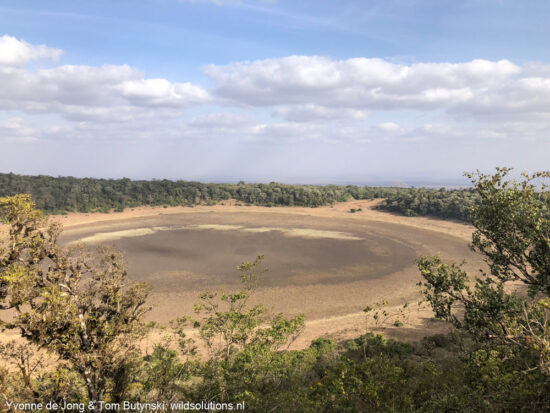
Lake Paradise, Marsabit National Park, in February 2023 during northern Kenya’s 5-year drought. This site appears to be particularly important for the survival of Grévy’s zebra in this national park.
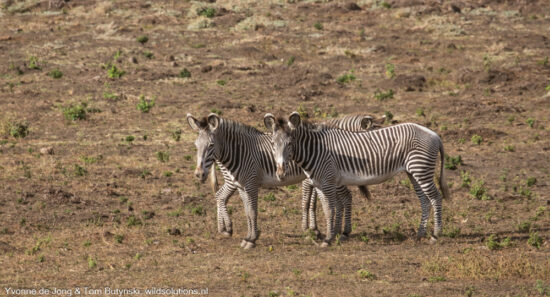
Adult Grévy’s zebra Equus grevyi, Lake Paradise, Marsabit National Park, northern Kenya, in February 2023 during northern Kenya’s 5-year drought.
Kenya’s population of Grévy’s zebra declined from about 13,700 individuals in the late 1970s to about 1,600 in 2017, an 88% decline. Nonetheless, Kenya holds about 90% of the world’s population of Grévy’s zebra (Rubenstein et al. 2016, KWS 2017, 2021). Conservation actions, conducted by organizations such as the Grevy’s Zebra Trust, Northern Rangeland Trust, and Kenya Wildlife Service, as well as by group ranches and private ranches, have served to increase Kenya’s population as of 2021 to somewhere between 2,650 and 3,000 individuals. About 1,000 Grévy’s zebra live in Laikipia County. Marsabit County has approximately 110 Grévy’s Zebra (KWS 2021). Habitat degradation, loss, and fragmentation due to over-grazing by livestock, as well as competition with livestock and people over water, are the main threats to Grévy’s zebra. Other treats include hunting by people in addition to disease, such as anthrax, due to contact with unvaccinated livestock (Williams 2002, 2013, Rubenstein et al. 2016, KWS 2017, 2021).
Other species of mammal in Marsabit National Park include African buffalo Syncerus caffer, bushbuck Tragelaphus scriptus, lesser kudu Tragelaphus imberbis, greater kudu Tragelaphus strepsiceros, Beisa oryx Oryx beisa beisa, gerenuk Litocranius walleri, Bright’s gazelle Nanger (granti) notata, reticulated giraffe Giraffa reticulata, savanna elephant Loxodonta africana, leopard Panthera pardus, spotted hyaena Crocuta crocuta, striped hyaena Hyaena hyaena, white-tailed mongoose Ichneumia albicauda, and ochre (Huet’s) bush squirrel Paraxerus ochraceus (Williams 1981, Butynski and De Jong personal observations).
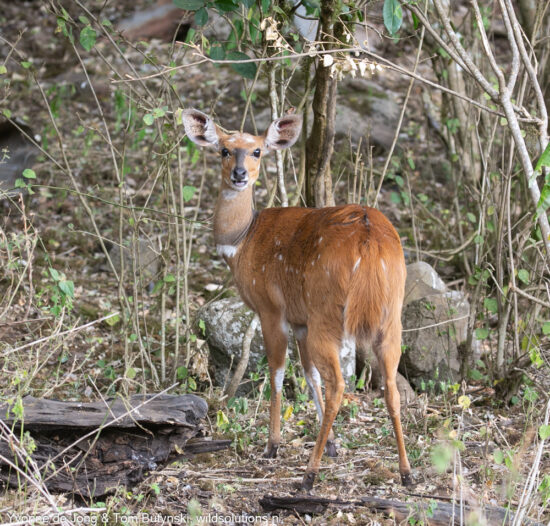
Adult female bushbuck Tragelaphus scriptus, Marsabit National Park, northern Kenya.
There is considerable misinformation about the wildlife of Marsabit National Park in the literature and on the www. For example, there are only three species of primate in Marsabit National Park. Olive baboon Papio anubis is common and northeastern vervet Chlorocebus pygerythrus arenaria is uncommon. Somali lesser galago Galago gallarum is present in the acacia woodlands. There is no support for reports that four additional species of primate occur on Mount Marsabit, or anywhere in this region: Thomas’s dwarf galago Galagoides thomasi, black-and-white colobus (guereza) Colobus guereza, patas monkey Erythrocebus patas, or Sykes’s monkey Cercopithecus mitis (Williams 1981, Grubb et al. 2003, De Jong and Butynski personal observations). Similarly, there is no evidence for the presence of East African springhare Pedetes surdaster (Williams 1981, Butynski and De Jong personal observations).
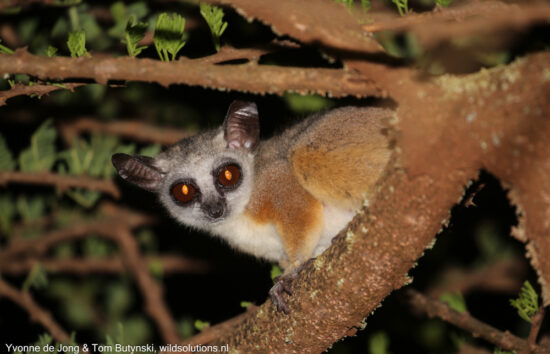
Adult female Somali lesser galago Galago gallarum near Marsabit National Park, northern Kenya.
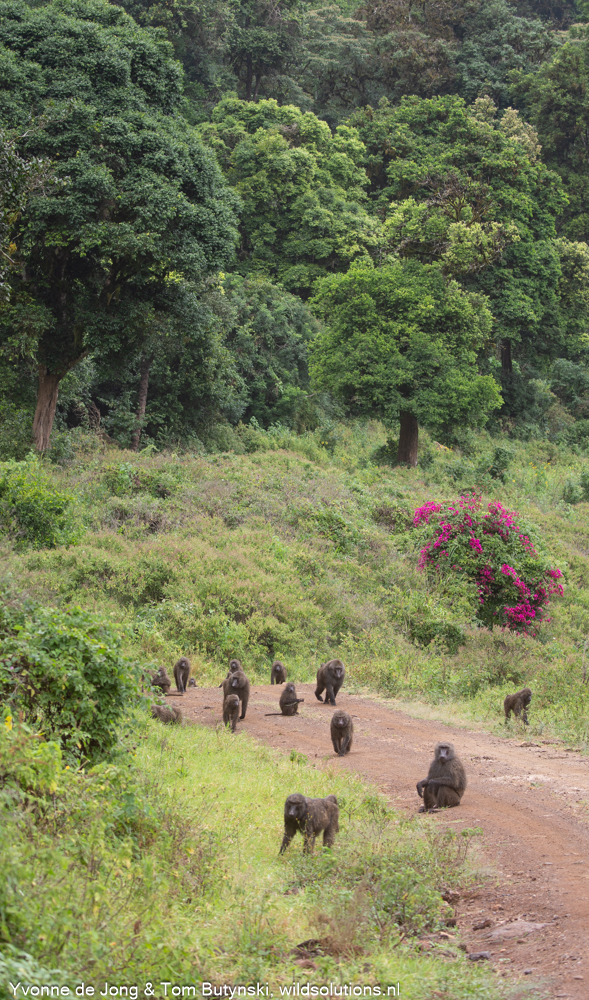
Olive baboons Papio anubis, Marsabit National Park, northern Kenya.
At least 360 species of bird, including 52 species of raptor, have been recorded for Marsabit National Park, many of which are migrants (Williams 1981).
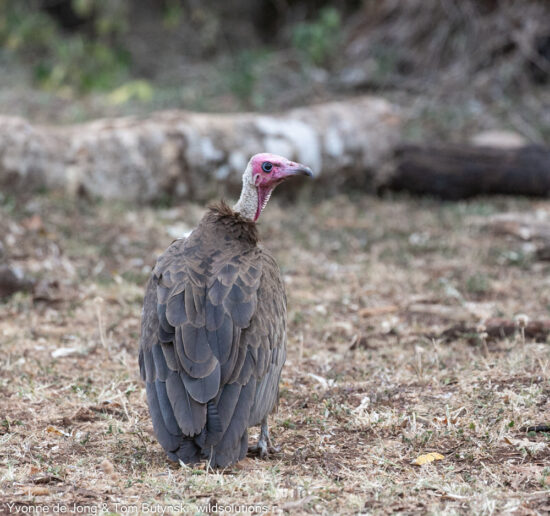
Adult hooded vulture Necrosyrtes monachus, Marsabit National Park, northern Kenya.
While the conservation value of Marsabit National Park remains high, particularly due to the fact that this mountain serves as a critical water catchment for this arid region and holds a unique biodiversity comprised of many globally threatened species, these values are in decline. Marsabit National Park is under threat, primarily as a result of the large number of people and livestock that live along its boundaries—and their ever-increasing numbers. The water catchment has been damaged due to the degradation and loss of forest and woodland. Biodiversity is in decline as some animal species have been lost. These include black rhinoceros Diceros bicornis, probably lion Panthera leo and wild dog Lycaon pictus, and several forest-dependent birds (Borghesio 2003).
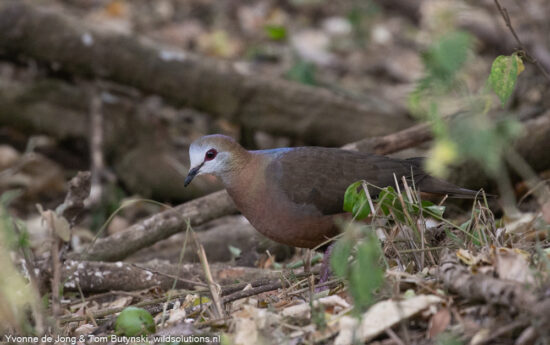
Adult lemon dove Aplopelia larvata, Marsabit National Park, northern Kenya.
Marsabit National Park was once famous as a refuge for elephants with exceptionally big tusks, most notably Ahmed whose tusks each weighed >68 kg (>150 lbs; Mohamed Amin Foundation). The days of the ‘big tuskers’ on Mount Marsabit seem to be gone.
Climate change is another major concern for this forest island and it forest-dependent species. If the climate becomes drier, the area covered by mid-altitude and montane forest will be reduced, as will the size of its populations of plants and animals. Given the great isolation of these forests, one result is likely to be in-breeding depression and eventual loss of many species.
Marsabit National Park, although far from Nairobi (~560 kms = ~350 mi), is now much more assessable than in the past due to a good tarmac highway system to Marsabit town. This is a scenic and unusual national park with a pleasant climate, few visitors, and an interesting and important biodiversity. All naturalists and seekers of a bit of adventure will find a visit to Marsabit National Park rewarding!
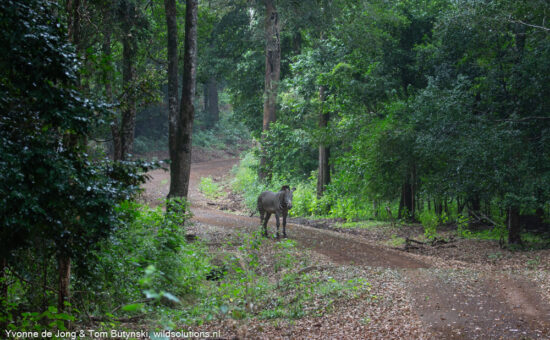
Adult male Grévy’s zebra Equus grevyi, Marsabit National Park, northern Kenya.
We thank Zoologische Gesellschaft für Arten- und Populationsschutz (ZGAP) for funding our Northeast Kenya Antelope Survey.
References
Borghesio, L. 2003? Le galago de Marsabit: pas encore découvert déjà disparu? CEPA Magazine 9: 8–9.
Grubb, P., Butynski, T.M., Oates, J.F., Bearder, S.K., Disotell, T.R., Groves, C.P. and Struhsaker, T.T. 2003. Assessment of the diversity of African primates. International Journal of Primatology 24: 1301–1357.
KWS. 2017. Recovery and Action Plan for Grevy’s Zebra (Equus grevyi) in Kenya (2017–2026). Kenya Wildlife Service, Nairobi, Kenya.
KWS. 2021. National Wildlife Census 2021 Report. Waweru, J. et al. (eds.). Unpublished report of the Kenya Wildlife Service, Nairobi, Kenya.
Mohamed Amin Foundation. Paste into your browser. ’Ahmed the Elephant: The King of Marsabit — Google Arts & Culture’
Rowen, M. and Ginsberg, J.R. 1992. Grévy’s zebra (Equus grevyi Oustalet). In: P. Duncan (ed.), Zebras, Asses, and Horses: An Action Plan for the Conservation of Wild Equids, pp. 10–12. IUCN/SSC Equid Specialist Group, Gland, Switzerland.
Rubenstein, D., Low Mackey, B., Davidson, Z.D., Kebede, F. and King, S.R.B. 2016. Equus grevyi. The IUCN Red List of Threatened Species 2016: e.T7950A89624491.
Scoon, R.N. 2022. Geological Highlights of East Africa’s National Parks. Struik Nature, Cape Town, South Africa.
Williams, J.G. 1981. A Field Guide to the National Parks of East Africa (2nd edition). Collins, London, UK.
Williams, S.D. 2002. Grévy’s zebra (Equus grevyi). In: P.D. Moehlman (ed.), Status Survey and Conservation Action Plan: Equids: Zebras, Asses and Horses, pp. 11–27. IUCN/SSC Equid Specialist Group, Gland, Switzerland.
Williams, S.D. 2013. Equus grevyi (Grévy’s zebra). In: J. Kingdon and M. Hoffmann (eds.), Mammals of Africa. Volume 6, Carnivores, Pangolins, Equids and Rhinoceroses, pp. 422–428. Bloomsbury Press, London, UK.
Tags: gallarum, grevy's zebra, lake paradise, Marsabit, north Kenya
Trackback from your site.
